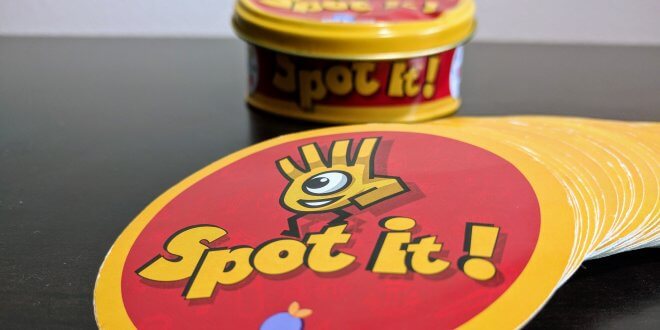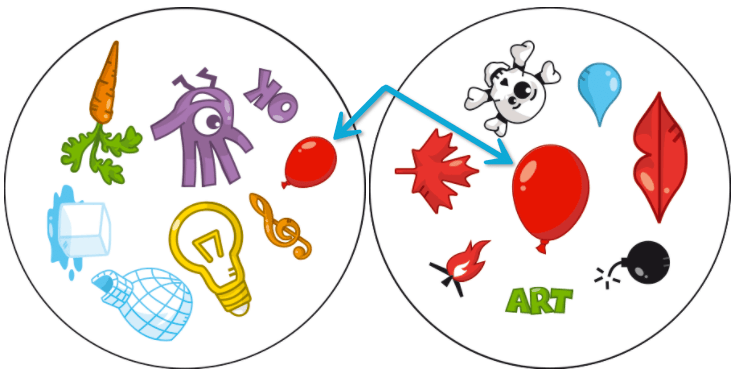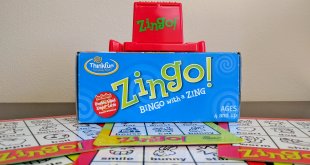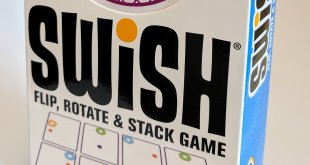QUICK STATS
7 years & up
2 to 8 players
15 minutes
Games, Card Games
Rich Classic
Pattern Recognition
Spatial Orientation
Time Pressure
What’s included & how to play Spot It
In the box you’ll find:
- 55 circular Spot It cards
- Rules that explain how to play the 5 game variations
- A round metal can to hold everything
Spot It is a clever design. The deck is composed of 55 cards with eight seemingly random images. Each of the five includes sets of rules (for different styles of play) revolves around you spotting a matching image on two different cards. The magic occurs when you realize that every single card has one image in common with every other card in the deck. Just one image and always exactly one image will match. Knowing that you’re looking for only one match, you begin to sort through all the potential matches between your card and the common card on the pile. But be fast! Every other player will be making this comparison at the same time, racing to see who can mentally decipher their particular match the fastest. Whoever finds a match first calls out the name of the symbol and picks up or discards a card, depending on which of the five mini-game sets of rules you’re playing.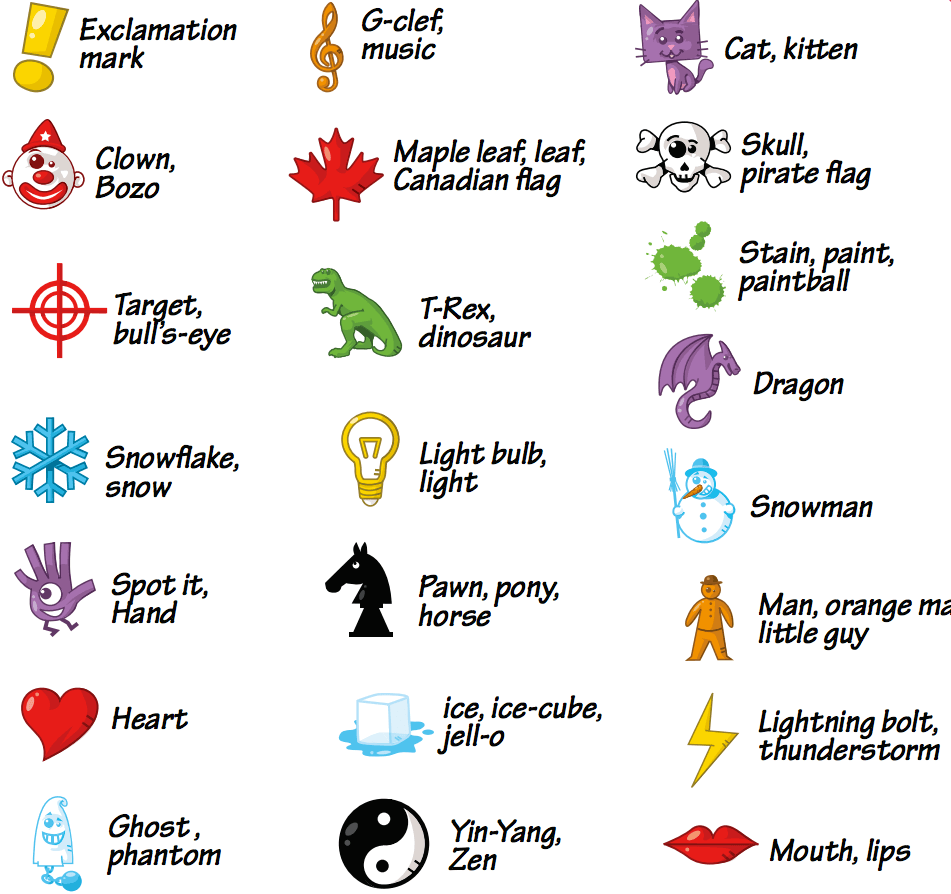
The fun part of this game happens when you get in a state of “flow.” Unlike any other game I’ve seen, Spot It can trigger an automatic, beautiful state of mind where you’re effortlessly calling out match after match. The match just appears in your mind, multiple consecutive times, and your hot streak is incredibly frustrating for everyone else. The flipside occurs when your brain is broken (as mine often is) and you just don’t see ANY of the same tiny pictures on the common card. You can study your own card for several minutes and the match never seems to materialize.
Spatial orientation is the baseline skill for a variety of STEM disciplines…
The value of Spot It occurs when you start to mentally move the images around on the card to form the match. Card pairs always have a matching image, but the orientation and size of the other image may be completely different than your own. I refer to this skill as “spatial orientation,” which is accompanied by the more obvious skill of “pattern recognition” that you employ to match the images. Spatial orientation is the baseline skill for a variety of STEM disciplines including architecture and engineering, as well as artistic endeavors like painting and photography. Graphic designers need to have this skill in abundance, and Spot It would definitely make a good gift for anyone who enjoys visual games. Finally, the competitive nature of Spot It yields more time pressure than most learning games. You’re constantly relearning the image set when your card or the common card is changed. For young kids, I recommend allowing them to play in a solo game where they can study the images as long as they’d like, without the external threat of a changed card every few seconds.
Is Spot It fun and educational?
Spot It is fun when you win and, even when you lose to a 4-year-old, which I do frequently, it’s never boring. The Rich Skills I mentioned in the How to Play section are surprisingly easy to see self-improvement as you have a blast playing Spot It for the hundredth time. The game scales well to a large number of players, up to eight, so it’s a viable option for classroom or party usage. This is one of those rare games that’s both good for your mind and highly entertaining. Imagine the healthiest vegetable you’ve ever eaten, and imagine that it tastes like your favorite dessert. It’s that good.
Complete Insanity, CandyChess, and Time2Play
Spot It sets the standard for what a perfect score looks like on our Complete Insanity measure. You can lose card after card and not affect play. You could still carry on with just a handful of the 55 cards, albeit in a very short game. The magic of having each card match all the others is that no card is special, which is ironic since they are all unique. Spot It gets a 5 out of 5 on this key benchmark, and it’s actually one of the games that made me create the Complete Insanity score–I realized that I want all games to be just like Spot It.
…no card is special, which is ironic since they are all unique.
Our CandyChess Strategy Score, at 3 out of 5, puts Spot It right in the middle between Candyland and Chess. There’s almost no strategy involved at all, but there is a lot of accumulated skill as your brain learns to process the images more quickly. The chance component is minimized by the fact that all players see the same common card. Being in the middle of the road on this index means that young/new players won’t be frustrated and experienced players won’t be bored, which is a win-win.
What ages of kids will enjoy Spot It?
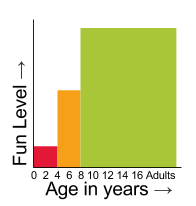
Our DistribuFun histogram for Spot It agrees with the manufacturer’s recommendation of “7 years & up,” but we show some nuance by displaying the yellow zone. Young kids, as soon as they can speak, will be able to play Spot It and even use it as a learning tool to increase their vocabulary. There are no dangerous or choking hazard parts to worry about, so as soon as your young ones can shout out the name of the shapes (and not try to ingest the large circular cards), start playing Spot It with them. There are versions of Spot It specifically designed to help lear numbers and letters, so if you’ve got kids that need to learn letters and numbers, start with those Spot It versions first.
Alternatives to Spot It that teach similar skills
For another time-pressure game that’s even brainier and also teaches spatial orientation (but with more logic and analysis), try another Rich Classic award-winner called Set. It skews slightly older but is equally fun and always humbling now that I realize that 3 out of 4 of my kids can routine demolish me. For a board-game alternative, consider Blokus, which lacks the time pressure but adds in multiple layers of strategy and logic.
Value, durability, and longevity: Is Spot It a good buy?
At around $12, you can’t go wrong. This is basically an impulse buy or stocking stuffer, and the extreme portability means that every vacation or day at the beach is an opportunity to pull out the Spot It deck. Asmodee even makes a waterproof version called Spot It Splash. The non-waterproof version we have is of course highly susceptible to wear and tear–they’re just normal cards–but the circular design seems to have prevented folding by our youngest kids. They like to fold anything and everything, which has destroyed several of our rectangular card games. After more than 5 years, our original game of set lives on, albeit in a very dented metal box.
 Learn Richly Learning toys, educational games and STEM resources
Learn Richly Learning toys, educational games and STEM resources 